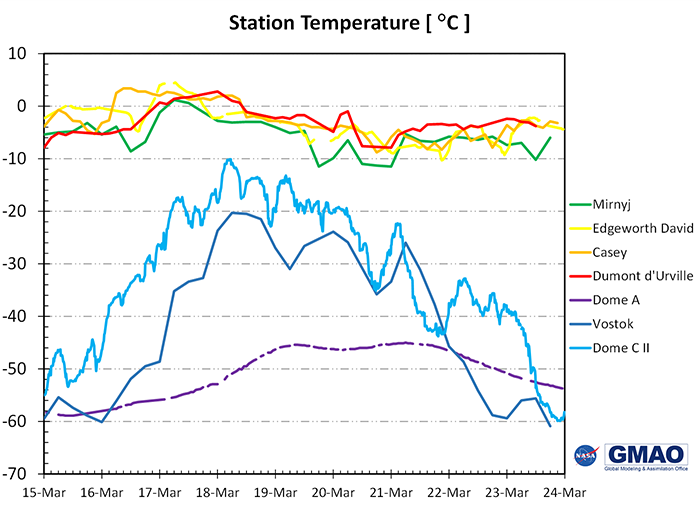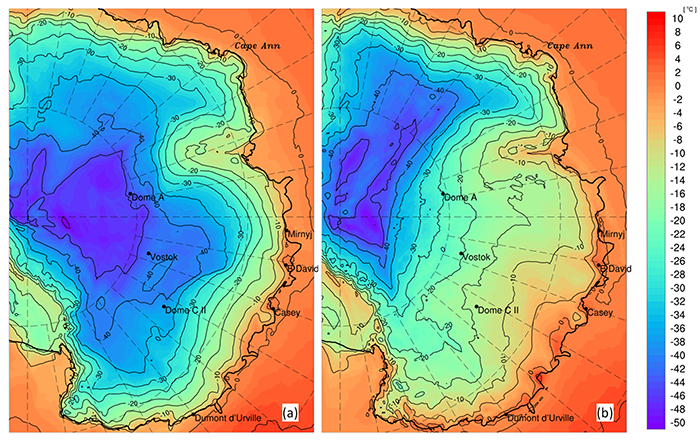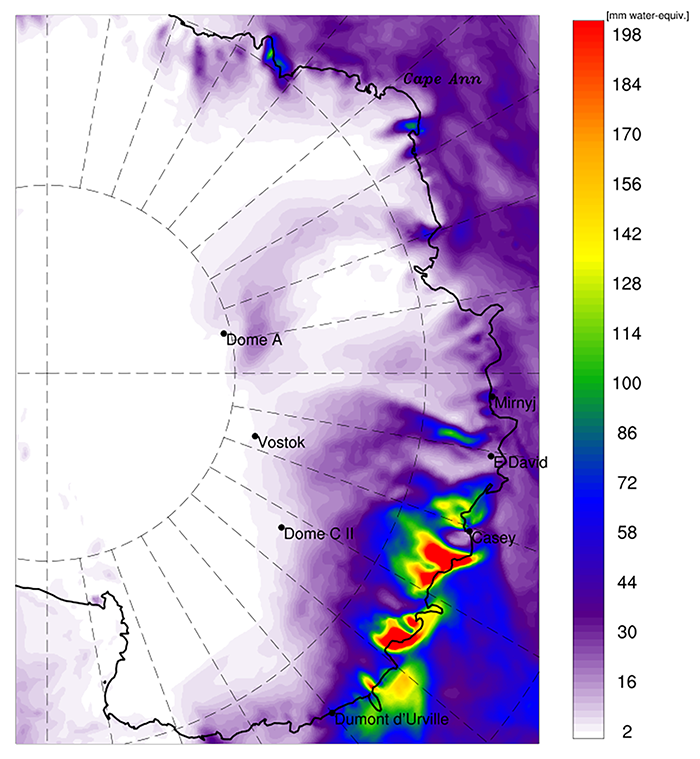An Atmospheric Blocking Event Shatters Temperature Records in East Antarctica
Scientists have used a variety of methods to examine the effects of a warming climate on the immense polar ice sheets of Greenland and Antarctica, and the impact of melting land ice on global sea level. A contemporary notion suggests a recent hemispheric contrast between the two ice sheets, where Greenland mass loss is mostly driven by atmospheric and surface processes, while Antarctic melting largely results from a warming ocean along the ice-ocean interface. For Antarctica, surface melt has been observed only in select locations, while air temperatures in the vast interior plateau have consistently remained well below freezing; a warming of the surrounding latitudes may in fact increase the moisture capacity of the atmosphere and result in increased snowfall over the ice sheet.
This perspective of a relatively benign atmospheric influence on Antarctica may be altered by the events and repercussions of March 2022, as seen in the analyses of the NASA GMAO forward-processing system (Animation 1). On 11-March a ridging pattern formed in the jet stream near Cape Ann. The ridge progressed eastward, but then deepened markedly into a classic omega-shaped blocking pattern over much of East Antarctica by the 14th. The blocking pattern is remarkable for the strength of the circulation – which forced warm air and moisture from lower latitudes into the high interior of the continent; its poleward extent – reaching far into the East Antarctic plateau; and its persistence. Air temperature observations at coastal East Antarctic stations indicated periods of above-freezing temperatures from the 16th through the 18th, which is unusual at the onset of polar winter in March (Figure 1). More stunning is the time series of temperatures taken from stations on the plateau. Dome A, the highest point on the ice sheet at 4084 m, warmed by 13.5°C over a four-day period. Further east, Vostok warmed from −60.1°C on 16-March to −20.3°C on the 18th, while Dome C temperatures warmed from −54.9°C to −10.1°C over a four-day period. Such temperature changes have not been previously seen in the observational record. Dome A and Dome C automatic stations date from 2005 and 1995, respectively, while Vostok records date from the 1957 International Geophysical Year.
Animation 1: GMAO forward-processing analysis for 11-23 March showing 2-m air temperature difference relative to 10-11 March, in °C (shaded), sea ice concentration (gray shaded), total precipitation in mm/hr (transparent shaded), and 500hPa geopotential height (contoured every 50m, bold contoured every 200m).
The spatial extent of the event may be seen in the analysis of maximum temperatures for the period 15-23 March shown in Fig. 2. Analysis systems including the GMAO have some difficulty reproducing the very coldest temperatures of the Antarctic interior. Nevertheless, the differences between this event and temperatures two weeks prior (1-9 March, 2022) are dramatic. The analysis suggests temperatures were above freezing along a large portion of the East Antarctic coastline at some point during the event.
Enhanced precipitation was a significant aspect of the event (Fig. 3). Snowfall from this event occurred at very high elevations over the interior plateau, where annual accumulation values have averaged only 50 mm water-equivalent. Along the coast, the analyzed precipitation values during the event exceeded 200 mm in large areas between Mirnyj and Dumont; some of this precipitation fell as rain. The presence of warmer temperatures and liquid precipitation coincided with a dramatic collapse of the Conger Ice Shelf.
The blocking pattern remained over the ice sheet through 19-March; on 20-March, analyses suggest that the ridge pinched off and became a high-pressure area separated from the main circulation. While this transition ended the coastal precipitation, warm air continued to circulate over the plateau, and conditions did not begin to return to normal until the 23rd.
Scientists are investigating several aspects of this event. Previous work has shown that rain and surface melt can fill crevasses on ice shelves, driving hydrofracture and ice shelf break up. The loss of an ice shelf may subsequently accelerate glacial floe to the sea. In addition, the focus area for this event was the Totten Glacier, which is subject to marine ice sheet instability. Continued monitoring will reveal if this atmospheric event results in dynamic changes to Totten Glacier and further mass loss for the ice sheet. Weather forecasts of the forward processing system began to identify and lock on to the plateau temperatures at about 5 days lead-time. Nevertheless, the driving mechanisms for the atmospheric event remain unclear. The stratospheric circulation and climate variables such as the Antarctic Oscillation Index (AAO) appear to show negligible signals for the event. Antarctic sea ice was known to be at record low levels during the onset, and it is of interest to understand whether oceanic conditions played a role. The presence of temperatures as warm as −10°C on the interior plateau at the onset of Antarctic winter is startling.
The event is reminiscent of North Atlantic blocking events that have recently afflicted the Greenland Ice Sheet in summer. It remains to be seen whether Antarctica, as with Greenland, will experience more frequent and persistent atmospheric blocking events in the future.





